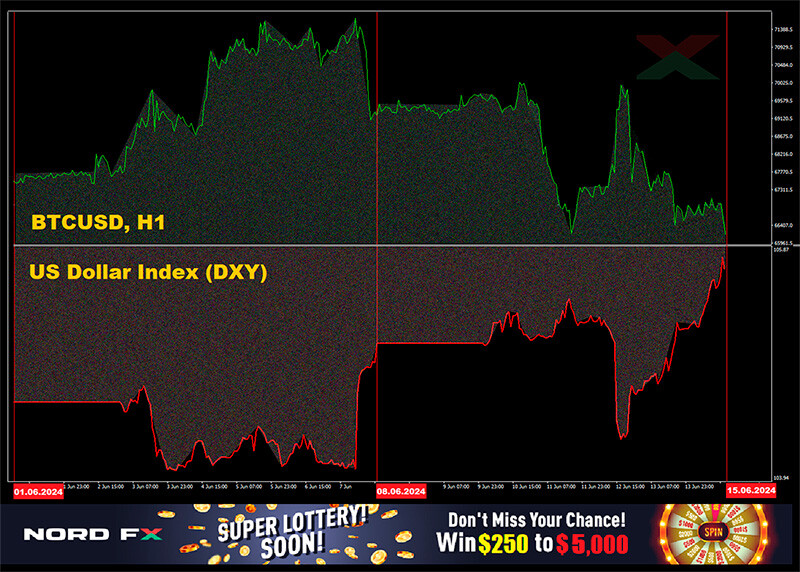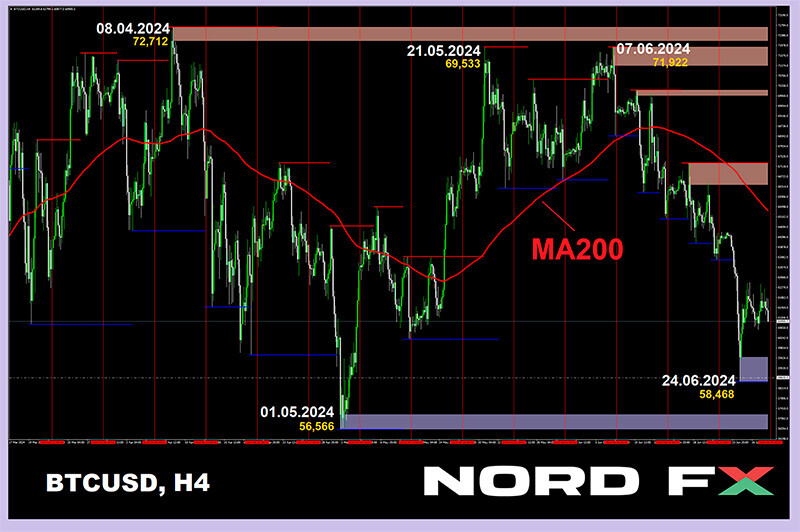- Dec 6, 2017
- 177
- 0
GBP/USD: What Will the Bank of England Decide on 20 June?
In autumn 2023, the BoE concluded that its monetary policy should remain tight for a prolonged period until inflation confidently stabilises at the target level of 2.0%. Based on this, despite a decrease in price pressure, at its meeting on 8 May, the Bank of England's Monetary Policy Committee (MPC) decided by a majority vote (seven to two) to keep the key interest rate at the previous level of 5.25%. (Two MPC members voted for a reduction to 5.0%).
According to the country's Office for National Statistics (ONS), since November 2022, the Consumer Price Index (CPI) has fallen from 11.1% to 2.3% – the lowest level since July 2021. The British central bank expects this figure to return to the target level in the near future but to increase slightly to around 2.5% in the second half of the year due to rising energy prices. Additionally, according to the May forecasts, CPI will be 1.9% in two years (Q2 2026) and 1.6% in three years (Q2 2027).
British inflation expectations for the near future have also decreased to the lowest level in almost three years, indicating a return to historically average levels. In May, the country's residents on average expected consumer prices to rise by 2.8% over the next 12 months, compared to a forecast of around 3% in February. This is stated in the results of the British central bank's quarterly survey.
Data on business activity (PMI) published in the first week of June indicated that the economy in the United Kingdom is relatively well. Activity in the manufacturing sector rose to 51.2 from 49.1 earlier. Some slowdown was shown by the PMI for the services sector – from 55.0 to 52.9, and the composite PMI – from 54.1 to 53.0. However, despite this, all these indicators remain above the 50.0 mark, separating growth from a slowdown in activity.
Certain concerns are raised by the UK labour market. Statistics published in early June showed a spike in jobless claims – by 50.4K in May after 8.4K the previous month. This is the largest monthly increase since the first COVID lockdowns. Before the pandemic, the last such spike was during the 2009 recession. Moreover, the unemployment rate for the February-April 2024 period rose to 4.4%. Of course, historically, this is a low level, but it is the highest in three years.
The next Bank of England meeting will be held on Thursday, 20 June. Analysts generally forecast that the interest rate will remain unchanged at 5.25%. This forecast is supported by the slowdown in inflation decline rates. Additionally, there is a significant increase in UK wages (+6.0%), which could push prices up. This, in turn, reduces the likelihood of the British central bank transitioning to a softer monetary policy in the near future. The start of QE may be delayed until September or later.
The BoE's tight monetary policy creates prerequisites for future demand for the pound. Meanwhile, last week, GBP/USD was driven by overseas data. On US inflation data, it broke through the upper boundary of the 1.2700-1.2800 channel and rose to 1.2860, then, following the FOMC meeting results, it fell and broke through the lower boundary, dropping to 1.2656. The week ended at 1.2686.
The median forecast of analysts for the near term is somewhat similar to the forecast for the previous pair. In this case, 50% of specialists voted for dollar strengthening, 25% for a northern trajectory, and 25% remained neutral. As for technical analysis on D1, the picture is also mixed. Trend indicators are evenly split 50:50 between red and green. Among oscillators, 60% point south (a quarter signal oversold), 20% look north, and the remaining 20% remain neutral. In case of further pair decline, support levels and zones are 1.2575-1.2600, 1.2540, 1.2445-1.2465, 1.2405, 1.2300-1.2330. In case of pair growth, resistance will be encountered at 1.2760, 1.2800-1.2820, 1.2865-1.2900.
Besides the mentioned Bank of England meeting on 20 June, including its interest rate decision and subsequent press conference, it is necessary to note Wednesday, 19 June, when fresh consumer inflation (CPI) data for the UK will be released. Friday, 21 June, also promises to be interesting. On this day, retail sales volumes and preliminary business activity (PMI) indicators in various sectors of the UK's economy will be known.
USD/JPY: BoJ Changed Nothing but Promised Changes in the Future
Unlike the Bank of England, the Bank of Japan (BoJ) meeting has already taken place, and its results were announced last Friday, 14 June. The yen's weakness in recent months has negatively impacted Asian currencies. In March, the central bank made its first move – raising the rate for the first time since 2007 (since 2016, it had kept it at a negative level of -0.1%). The regulator also abandoned the targeting of 10-year government bond yields. Investors closely watched the Japanese central bank for hints on whether it would further unwind monetary stimulus.
But for now, the BoJ decided not to change its accommodative monetary policy, maintaining the current pace of bond purchases at around 6 trillion yen ($38 billion) per month. However, it promised to present a plan for their gradual reduction at the next meeting in July. "We decided to subsequently reduce the volume of our purchases [within one to two years] to ensure more free formation of long-term interest rates in financial markets," the central bank statement said. At the same time, the regulator announced that it would gather market participants' opinions before making a specific decision.
The deposit rate for commercial banks was also left unchanged – officials unanimously voted to keep it in the range of 0.0%-0.1%, as expected. From this, experts once again concluded that the BoJ would not rush to tighten its quantitative easing (QT) monetary policy.
The French bank Societe Generale believes that given the pressure from the government due to the weak yen, the most likely scenario will be a reduction in bond purchases starting in August, with their purchases decreasing every three months and reaching zero by November 2025. Additionally, according to Societe Generale economists, the BoJ may raise the discount rate in September this year.
Of course, USD/JPY could not ignore such events of the past week as the US CPI figures and the Fed meeting: its fluctuation range exceeded 240 points (155.71 at the low, 158.25 at the high). However, the five-day result was not so impressive: starting at 156.75, it ended at 157.37.
Experts' forecasts for the near term look like this: not a single vote was given for the pair's southern movement and yen strengthening, while the remaining votes were evenly split: 50% pointed north, and 50% remained neutral. As for technical analysis, all trend indicators on D1 are coloured green. The nearest support level is in the 156.80-157.05 zone, followed by 156.00-156.10, 155.45, 154.50-154.70, 153.10-153.60, 151.85-152.15, 150.80-151.00, 149.70-150.00, 148.40, 147.30-147.60, 146.50. The nearest resistance lies in the 157.70 area, followed by 158.25-158.60, 160.00-160.20.
No significant economic statistics releases for Japan are scheduled for the upcoming week.
continued below...
In autumn 2023, the BoE concluded that its monetary policy should remain tight for a prolonged period until inflation confidently stabilises at the target level of 2.0%. Based on this, despite a decrease in price pressure, at its meeting on 8 May, the Bank of England's Monetary Policy Committee (MPC) decided by a majority vote (seven to two) to keep the key interest rate at the previous level of 5.25%. (Two MPC members voted for a reduction to 5.0%).
According to the country's Office for National Statistics (ONS), since November 2022, the Consumer Price Index (CPI) has fallen from 11.1% to 2.3% – the lowest level since July 2021. The British central bank expects this figure to return to the target level in the near future but to increase slightly to around 2.5% in the second half of the year due to rising energy prices. Additionally, according to the May forecasts, CPI will be 1.9% in two years (Q2 2026) and 1.6% in three years (Q2 2027).
British inflation expectations for the near future have also decreased to the lowest level in almost three years, indicating a return to historically average levels. In May, the country's residents on average expected consumer prices to rise by 2.8% over the next 12 months, compared to a forecast of around 3% in February. This is stated in the results of the British central bank's quarterly survey.
Data on business activity (PMI) published in the first week of June indicated that the economy in the United Kingdom is relatively well. Activity in the manufacturing sector rose to 51.2 from 49.1 earlier. Some slowdown was shown by the PMI for the services sector – from 55.0 to 52.9, and the composite PMI – from 54.1 to 53.0. However, despite this, all these indicators remain above the 50.0 mark, separating growth from a slowdown in activity.
Certain concerns are raised by the UK labour market. Statistics published in early June showed a spike in jobless claims – by 50.4K in May after 8.4K the previous month. This is the largest monthly increase since the first COVID lockdowns. Before the pandemic, the last such spike was during the 2009 recession. Moreover, the unemployment rate for the February-April 2024 period rose to 4.4%. Of course, historically, this is a low level, but it is the highest in three years.
The next Bank of England meeting will be held on Thursday, 20 June. Analysts generally forecast that the interest rate will remain unchanged at 5.25%. This forecast is supported by the slowdown in inflation decline rates. Additionally, there is a significant increase in UK wages (+6.0%), which could push prices up. This, in turn, reduces the likelihood of the British central bank transitioning to a softer monetary policy in the near future. The start of QE may be delayed until September or later.
The BoE's tight monetary policy creates prerequisites for future demand for the pound. Meanwhile, last week, GBP/USD was driven by overseas data. On US inflation data, it broke through the upper boundary of the 1.2700-1.2800 channel and rose to 1.2860, then, following the FOMC meeting results, it fell and broke through the lower boundary, dropping to 1.2656. The week ended at 1.2686.
The median forecast of analysts for the near term is somewhat similar to the forecast for the previous pair. In this case, 50% of specialists voted for dollar strengthening, 25% for a northern trajectory, and 25% remained neutral. As for technical analysis on D1, the picture is also mixed. Trend indicators are evenly split 50:50 between red and green. Among oscillators, 60% point south (a quarter signal oversold), 20% look north, and the remaining 20% remain neutral. In case of further pair decline, support levels and zones are 1.2575-1.2600, 1.2540, 1.2445-1.2465, 1.2405, 1.2300-1.2330. In case of pair growth, resistance will be encountered at 1.2760, 1.2800-1.2820, 1.2865-1.2900.
Besides the mentioned Bank of England meeting on 20 June, including its interest rate decision and subsequent press conference, it is necessary to note Wednesday, 19 June, when fresh consumer inflation (CPI) data for the UK will be released. Friday, 21 June, also promises to be interesting. On this day, retail sales volumes and preliminary business activity (PMI) indicators in various sectors of the UK's economy will be known.
USD/JPY: BoJ Changed Nothing but Promised Changes in the Future
Unlike the Bank of England, the Bank of Japan (BoJ) meeting has already taken place, and its results were announced last Friday, 14 June. The yen's weakness in recent months has negatively impacted Asian currencies. In March, the central bank made its first move – raising the rate for the first time since 2007 (since 2016, it had kept it at a negative level of -0.1%). The regulator also abandoned the targeting of 10-year government bond yields. Investors closely watched the Japanese central bank for hints on whether it would further unwind monetary stimulus.
But for now, the BoJ decided not to change its accommodative monetary policy, maintaining the current pace of bond purchases at around 6 trillion yen ($38 billion) per month. However, it promised to present a plan for their gradual reduction at the next meeting in July. "We decided to subsequently reduce the volume of our purchases [within one to two years] to ensure more free formation of long-term interest rates in financial markets," the central bank statement said. At the same time, the regulator announced that it would gather market participants' opinions before making a specific decision.
The deposit rate for commercial banks was also left unchanged – officials unanimously voted to keep it in the range of 0.0%-0.1%, as expected. From this, experts once again concluded that the BoJ would not rush to tighten its quantitative easing (QT) monetary policy.
The French bank Societe Generale believes that given the pressure from the government due to the weak yen, the most likely scenario will be a reduction in bond purchases starting in August, with their purchases decreasing every three months and reaching zero by November 2025. Additionally, according to Societe Generale economists, the BoJ may raise the discount rate in September this year.
Of course, USD/JPY could not ignore such events of the past week as the US CPI figures and the Fed meeting: its fluctuation range exceeded 240 points (155.71 at the low, 158.25 at the high). However, the five-day result was not so impressive: starting at 156.75, it ended at 157.37.
Experts' forecasts for the near term look like this: not a single vote was given for the pair's southern movement and yen strengthening, while the remaining votes were evenly split: 50% pointed north, and 50% remained neutral. As for technical analysis, all trend indicators on D1 are coloured green. The nearest support level is in the 156.80-157.05 zone, followed by 156.00-156.10, 155.45, 154.50-154.70, 153.10-153.60, 151.85-152.15, 150.80-151.00, 149.70-150.00, 148.40, 147.30-147.60, 146.50. The nearest resistance lies in the 157.70 area, followed by 158.25-158.60, 160.00-160.20.
No significant economic statistics releases for Japan are scheduled for the upcoming week.
continued below...











